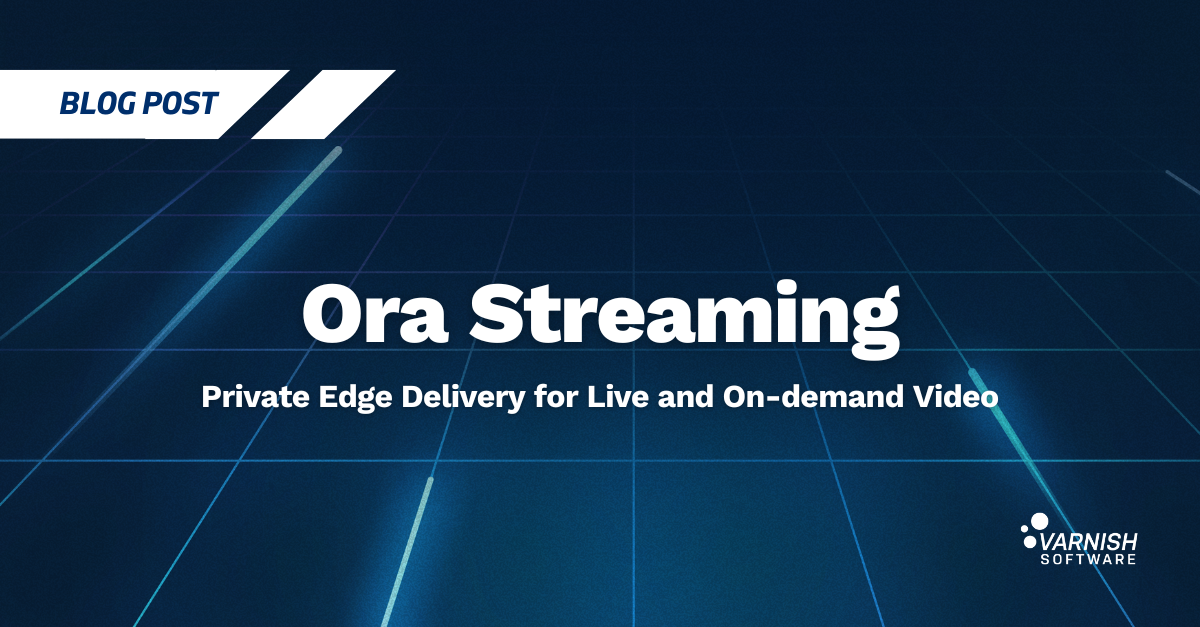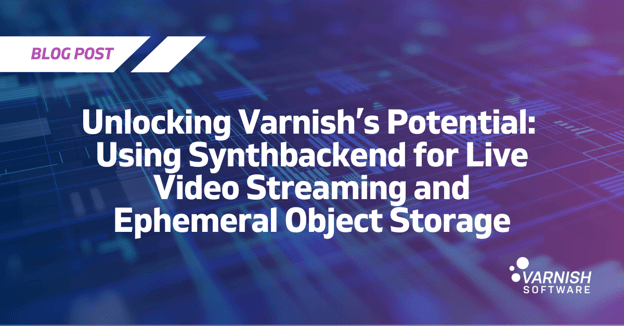Building a Private CDN, sometimes referred to as DIY CDN, is a theme that has been discussed in the world of content delivery for more than a decade, and it continues to be a relevant subject for many reasons. For the past two years, Private CDN has gained even more interest, especially in the light of quite a few companies with the traditional CDN model exiting the market, going bust, and reporting massive losses every quarter. Few seem to care that they are actually subsidizing their $/GB per month price with their shareholders' money, and have been for a very long time.
Even if the CDN sector is not the most exciting in the IT industry, the number of bytes needing to be delivered across the globe is not going to decrease. One of the largest future drivers will be distribution of AI Inference models to the edge.
However, the main challenge on the internet today is video distribution. In fact, most analysts seem to agree that it is about 70-80% of internet traffic. In addition to traditional CDNs delivering videos, we have seen some of the world’s largest video content providers implement Private CDNs successfully.
Building a Private CDN can be a major undertaking
And it must be driven by a desire to reach some strategic goals. This usually includes:
- Full control of your video distribution, from an operational, commercial, and QoE point of view
- Unique access to data on customer behavior, far beyond what any traditional CDN is able to provide. The value of this data can be massive: this reason alone may justify a Private CDN strategy for some companies
- No dependency on a single CDN vendor with an unknown future or that can gradually increase their pricing
- Ability to innovate by having a dedicated (not shared) platform that does not come with the usual restrictions, allowing for the ability to create a competitive edge
- Lower and more predictable costs
- Requirement to deliver in a geography or region where there may be only one or no CDN vendors available (and/or the cost is very high)
Building (or DIY) a Private CDN is not exactly rocket science in 2025, but it certainly will require a strategic decision and a commitment to long-term efforts, skill set and CapEx budget, especially for video distribution at scale.
Building a Private CDN consists of:
1. Caching software, control plane software and traffic plane.
There are open source options, but at some point it may be necessary to fork to make them work according to your requirements. Having spent 25 years mainly dealing with open source technologies and related business, I know that “thou shalt not fork" is one of the golden rules. “Fork” means that you take a snapshot of the source code and modify it according to your requirements. Having done that, there is seldom a way back to being able to use new versions and releases of the software: you are stuck with your decision, but sometimes that is the best way to go. You will, however, need to have the budget and technical resources (and they need to be at core developer level) assigned not only to do the changes but be prepared to do the maintenance required for the entire product lifecycle, let’s say a minimum of 5 years.
This is what most traditional CDNs have been doing. Most CDNs today are based on open source versions of Squid, Apache Traffic Server, Varnish Cache, or NGINX. For the CDNs, this is core business and works well as long as they can keep their versions secure, bug free, reasonably performant and updated according to new standards and basic features.
In addition, we have seen a few of the giants of streaming do the same and build their own content delivery on an open source stack. An alternative here is to buy CDN Software from a software vendor, of course. That would give you support, SLA, indemnification, a roadmap and new releases. But it comes with a cost and dependencies.
2. You need to budget and acquire the server infrastructure.
This is usually a significant CapEx number.
3. Hosting, network and peering
The next part can be a lot trickier than it sounds. You need to negotiate racking, hosting, network connectivity and peering to different ISPs. This could be a significant undertaking and does require a special skill set.
You could argue that Public Cloud vendors could be used for Video Delivery here. Cloud vendors perform very well in so many areas, but video delivery at scale usually comes with very high egress costs, so we have seen few examples where this is financially viable.
4. Operations
Finally you need to build your own operations team with SREs, network engineers and DevOps teams that most often need to cover 24/7/365.
Taken together, it is usually a pretty big decision to make. But for some it has made sense and been very successful.
But what is the alternative?
But what if you are not one of the global giants, know very little about open source, software development, and have absolutely no plans (or budget) to acquire hardware, negotiate with carriers and ISPs and set up a team running the video delivery operations 24/7?
At Varnish Software we have been providing CDN software for a number of years. We started as an open source cache, but then found out that Enterprise Customers had very different requirements, which added complexity way beyond what the average Open Source user needed.
We therefore started building a proprietary version of Varnish, with enhanced security, resilience and performance, and over the last five years also developed control plane and traffic plane capabilities to enable our customers to implement their own Private CDN based on a complete CDN Software Suite.
In parallel we have for the last six years been working very closely with Intel, to make sure that Varnish Technology is the most performant caching and CDN technology available. Intel's input in this process has been extremely valuable and together we have announced a number of new benchmark records for performance and power efficiency on off-the-shelf servers. In 2024 we jointly announced 1.5 Tbps performance with excellent power efficiency at up to 1.4 Gbps/ Watt.
Looking at the results coupled with video being a volume business requiring high bandwidth, it became clear to us that customers would be interested in a different model than being charged for every bit being delivered.
The answer: Streaming-as-a-Service
 This made us decide to take the next step in the collaboration between Intel and Varnish Software. We wanted to come up with a new model that would make it possible for video content providers to use a Private CDN without having to deal with any of the challenges in DIY (steps 1-4 above). Our goal was to make it as easy as adding another CDN into the customer's multi-CDN strategy, but with all the benefits of a Private CDN.
This made us decide to take the next step in the collaboration between Intel and Varnish Software. We wanted to come up with a new model that would make it possible for video content providers to use a Private CDN without having to deal with any of the challenges in DIY (steps 1-4 above). Our goal was to make it as easy as adding another CDN into the customer's multi-CDN strategy, but with all the benefits of a Private CDN.
At NAB next week we will officially launch this new initiative. It all comes together in a new legal entity, Ora Streaming Inc. Varnish Software provides Varnish Enterprise CDN Software and Managed Service and support 24/7/365, all delivered by Varnish engineers. Intel, who have worked with Tier-1 ISPs and carriers, are leveraging their partnerships in order to provide Edge Bare Metal servers inside of their networks. As a result, Ora Streaming can offer more than 100 PoPs with excellent peering.
The model is all OpEx. Customers pay a fixed fee per month for a certain capacity, with no additional cost for egress, port fees, traffic or overage. This means that the more you utilize the capacity, the lower the cost per GB/month will be.
Setting up and running a Varnish Enterprise Private CDN today is less expensive than running a traditional shared CDN service. This is because the complexity in terms of configuration and management of a multi-tenant shared environment is significantly higher than a single tenant Private CDN. This means that you can expect the cost of Ora Streaming to be lower than your current CDN Service. In addition, cost for Edge Compute is included in the monthly fixed price. This is because even if Varnish is running at full speed and saturating the network interface, approximately 50% of the compute capacity still remains unused. Because of the fixed price model, the customer has already paid for the server and can utilize this capacity without paying more.
After talking to prospects and onboarding our first customers, we are very excited about this new model and think it will play a key role in many organizations' CDN strategies and because of this, we are looking forward to officially launching Ora Streaming at NAB in Las Vegas next week!
If you are there, please come by Booth W3848 if you want to hear more!
Written by Lars Larsson, co-founder of Varnish Software and Head of Ora Streaming
/VS-logo-2020-197x60.png?width=136&height=60&name=VS-logo-2020-197x60.png)



